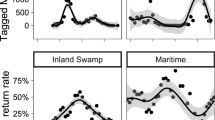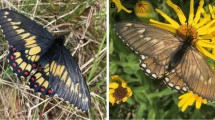Abstract
Like most migratory species, monarch butterflies (Danaus plexippus) must stop frequently during their long southward migration to rest and refuel, and the places where they stop are important for the success of the migration. The behavior of monarch butterflies at migratory stopover sites has never been examined in detail. Here we present results of a long-term study of monarchs at one stopover site in coastal South Carolina where over 12,000 monarchs have been captured, measured and tagged (with numbered stickers to track recovery rates) over 13 years. Only 3 monarchs (0.023%) were recovered at the monarchs’ overwintering sites in Mexico, which is consistent with other tagging studies on the eastern coast. The migration season was longer at this site than at inland locations and monarchs continued to be captured in November and December, when most monarchs had already arrived at the overwintering areas in Mexico. In addition, there were 94 monarchs captured between Jan 1 and Mar 15, indicating that some monarchs overwinter at this site. Of all monarchs captured during the migration season, 80% were captured while nectaring and 10% while roosting. Others were basking, resting, flying and even mating. The sex ratio was male biased by three to one in all behavior categories except those captured mating. Roosting and nectaring monarchs had fresher wings than those in other behavior categories, suggesting that these are younger individuals. There were 13 observations of females ovipositing on non-native Asclepias curassavica during the fall months, which speaks to the potential for this plant to pull monarchs out of the migratory pool. Aside from these insights, this study also serves as an example of the potential that monarch tagging studies have to advance scientific understanding of monarch migration.





Similar content being viewed by others
References
Altizer S, Davis AK (2010) Populations of monarch butterflies with different migratory behaviors show divergence in wing morphology. Evolution 64:1018–1028
Altizer SM, Oberhauser K, Brower LP (2000) Associations between host migration and the prevalence of a protozoan parasite in natural populations of adult monarch butterflies. Ecol Entomol 25:125–139
Altizer SM, Oberhauser K, Geurts KA (2004) Transmission of the protozoan parasite, Ophryocystis elektroscirrha, in monarch butterfly populations. In: Oberhauser K, Solensky M (eds) The monarch butterfly. Biology and conservation. Cornell University Press, Ithaca, pp 203–218
Beall G (1948) The fat content of a butterfly, Danaus plexippus, as affected by migration. Ecology 29:80–94
Beck J (2008) Phylogenetic and ecological correlates with male adult life span of rainforest butterflies. Evol Ecol 22:507–517
Borland J, Johnson CC, Crumpton TW III, Thomas M, Altizer S, Oberhauser K (2004) Characteristics of fall migratory monarch butterflies, Danaus plexippus, in Minnesota and Texas. In: Oberhauser K, Solensky M (eds) The monarch butterfly, biology and conservation. Cornell University Press, Ithaca, pp 97–104
Brindza L, Brower LP, Davis AK, Van Hook T (2008) Comparative success of monarch butterfly migration to overwintering sites in Mexico from inland and coastal sites in Virginia. J Lepid Soc 62:189–200
Brower LP, Fink LS, Walford P (2006) Fueling the fall migration of the monarch butterfly. Integr Comp Biol 46:1123–1142
Brown JJ, Chippendale GM (1974) Migration of the monarch butterfly, Danaus plexippus: energy sources. J Insect Physiol 20:1117–1130
Calvert WH, Brower LP (1986) The location of monarch butterfly (Danaus plexippus L.) overwintering colonies in Mexico in relation to topography and climate. J Lepid Soc 40:164–187
Davis AK, Garland MS (2004) Stopover ecology of monarchs in coastal Virginia: using ornithological methods to study monarch migration. In: Oberhauser K, Solensky M (eds) The monarch butterfly. Biology and conservation. Cornell University Press, Ithaca, pp 89–96
Davis AK, Rendon-Salinas E (2010) Are female monarch butterflies declining in eastern North America? Evidence of a 30-year change in sex ratios at Mexican overwintering sites. Biol Lett 6:45–47
Dockx C, Brower LP, Wassenaar LI, Hobson KA (2004) Do North American monarch butterflies travel to Cuba? Stable isotope and chemical tracer techniques. Ecol Appl 14:1106–1114
Garland MS, Davis AK (2002) An examination of monarch butterfly (Danaus plexippus) autumn migration in coastal Virginia. Am Midl Nat 147:170–174
Gibbs D, Walton R, Brower L, Davis AK (2006) Monarch butterfly (Lepidoptera, Nymphalidae) migration monitoring at Chincoteague, VA and Cape May, NJ: a comparison of long-term trends. J Kansas Entomol Soc 79:156–164
Gibo DL, McCurdy JA (1993) Lipid accumulation by monarch butterflies (Danaus plexippus L.). Can J Zool 71:76–82
Herman WS (1985) Hormonally mediated events in adult monarch butterflies. In Rankin MA (ed) Migration: mechanisms and adaptive significance. Contibutions to Marine Science 27 (suppl.): 799–815
Herman WS (1988) Body weight and wing length changes in Minnesota populations of the monarch butterfly. J Lepid Soc 42:32–36
Howard E, Davis AK (2004) Documenting the spring movements of monarch butterflies with Journey North, a citizen science program. In: Oberhauser K, Solensky M (eds) The monarch butterfly. Biology and conservation. Cornell University Press, Ithaca, pp 105–114
Howard E, Davis AK (2009) The fall migration flyways of monarch butterflies in eastern North America revealed by citizen scientists. J Insect Conserv 13:279–286
Howard E, Aschen H, Davis AK (In Press). Citizen science observations of monarch butterfly overwintering in the southern United States. Psyche
Knight A, Brower LP (2009) The influence of eastern North American autumnal migrant monarch butterflies (Danaus plexippus L.) on continuously breeding resident monarch populations in southern Florida. J Chem Ecol 35:816–823
Malcolm SB, Zalucki MP (1993) Biology and conservation of the monarch butterfly. Natural History Museum of Los Angeles County
MonarchLab Website (2008) Vital statistics: wing condition scoring. http://www.monarchlab.org/research/VS/measure2.html. Accessed October 2, 2008
MonarchWatch (2008) MonarchWatch http://monarchwatch.org/. Accessed Oct 20, 2009
Oberhauser K, Solensky M (2004) The monarch butterfly. Biology and conservation. Cornell University Press, Ithaca
Statistica (2003) Statistica version 6.1, Statsoft Inc
Urquhart FA (1960) The monarch butterfly. Univ. Toronto Press, Toronto
Urquhart FA, Urquhart NR (1979) Breeding areas and overnight roosting locations in the northern range of the monarch butterfly (Danaus plexippus plexippus) with a summary of associated migratory routes. Can Field Nat 93:41–47
Walton RK, Brower LP, Davis AK (2005) Long-term monitoring and fall migration patterns of the monarch butterfly (Nymphalidae: Danainae) in Cape May, NJ. Ann Entomol Soc Am 98:682–689
Williams CB, Cockbill GF, Gibbs ME, Downes JA (1942) Studies in the migration of lepidoptera. Trans R Entomol Soc Lond 92:102–281
Acknowledgements
A number of people participated with capturing and tagging monarchs for this project. The most significant contributors were past and present employees of the Charleston County Parks and Recreation Commission (CCPRC), Marvin Bouknight, Billy Drakeford, Brad Jaynes and Keith McCullough. During several years, CCPRC was very helpful in the purchase of tags from Monarch Watch. Financial and logistic support for the field work was provided in some years by the South Carolina Dept. of Natural Resources (SCDNR), for which specific gratitude is expressed to David Whitaker, Assistant Deputy Director for Marine Resources, SCDNR. The principal author is also grateful for the inspiration provided by hundreds of elementary and kindergarten students in the Charleston area, and most notably students and teachers at Stiles Point Elementary School, James Island, SC, for their participation in the release of many hundreds of tagged monarchs. We thank Sean Sterrett for assistance with the figures for the manuscript. AKD was supported by the Morris Animal Foundation while preparing the manuscript.
Author information
Authors and Affiliations
Corresponding author
Rights and permissions
About this article
Cite this article
McCord, J.W., Davis, A.K. Biological Observations of Monarch Butterfly Behavior at a Migratory Stopover Site: Results from a Long-term Tagging Study in Coastal South Carolina. J Insect Behav 23, 405–418 (2010). https://doi.org/10.1007/s10905-010-9224-x
Revised:
Accepted:
Published:
Issue Date:
DOI: https://doi.org/10.1007/s10905-010-9224-x




